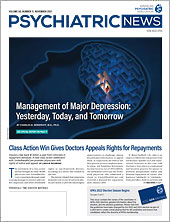Discrimination is one of the most destructive social determinants of mental health. Discrimination and its associated social exclusion can be based on race, ethnicity, nationality, gender, age, disability, or other perceived vulnerability. Ubiquitous and pervasive, it can be overt or implicit—but in all circumstances, it is exploitative and immoral. It occurs in psychiatric training, clinical practice settings, academic departments, research arenas, and administrative policies. It can be found in virtually all areas of medicine. It is based on a common relationship paradigm of the strong versus the weak, reflecting its relevance to power and authority. Such a culture of exclusion and exploitation originally evolved in a world of medicine populated overwhelmingly by privileged White men.
Such exploitation and exclusion are clearly based on race and gender but can be based on virtually any kind of difference. The Association of American Medical Colleges (AAMC) published a detailed chart of chairs of psychiatry divided into categories such as race and gender (2015). They reported that only 10% were White women, and none were women of color. The Lancet in 2020 reported that whereas 46% of all physicians in medicine are now women, the number of tenured women is only 12%.
Another example is the physical and mental abuse of medical students, traditionally and ironically accepted as an integral part of medical training. Since 1978, the AAMC Graduation Questionnaire has been administered yearly to graduating medical students to provide feedback to medical schools to improve student experience. Although in 2020 satisfaction with medical school education was generally high, about 40% of respondents reported experiencing abusive behavior; the questionnaire listed 16 types, including hazing, public humiliation, derogatory remarks, bullying, intimidation, harassment, retaliation, and discrimination based on gender, race, sexual identity, sexual orientation, physical appearance, or other personal traits or beliefs. (See
here.)
Medical lore has enshrined the concept of “see one-do one-teach one.” And thus it comes as no surprise that attitudes learned from medical school experiences can carry over into the ways that practicing physicians might approach patients. This can result in tacit discrimination against patients with mental illness, for example. This can also result in institutionalized stigma: Structural policies of private organizations and government that tend to impose limitations on people with mental illness. Examples include lower funding for research or fewer mental health services relative to other health care. On May 6, the
New England Journal of Medicine published a
distressing and compelling article written by psychiatrists Eric Rafla-Yuan, M.D., Divya K. Chhabra, M.D., and Michael O. Mensah, M.D., M.P.H., about the deaths and failure of U.S. mental health emergency services related to discrimination.
What characterizes these several examples is at best a thoughtlessness that belies prejudice and at worst a purposeful intent to maintain or increase power regardless of the harm inflicted. A shift in attitude is required, from one of indifference or malintent to one of acknowledging our role in maintaining an environment that weakens people. In psychiatry, if we do not have empathy and compassion for our students, trainees, and patients, then we are not acting with professional integrity. Progress will continue to apply only to some people, and too many will be left out. However, if we embrace the idea that there are enough resources for everyone—money, power, prestige—then everyone can benefit.
No amount of mentoring students or helping patients to manage the harm they endure by discrimination will reduce the self-inflicted psychological injury that many psychiatrists ironically experience. If the main task of psychiatry is to diagnose and treat individuals suffering from a mental illness, then an inclusive, diverse, and unbiased approach must be employed, one that does not discriminate and fail to take into account the social determinants of mental health.
As long as we remain complicit with systems that conflict with our moral compass, we will all suffer moral injury and associated burnout. The COVID-19 pandemic has enabled, perhaps even forced, many people to re-examine their options and what they are willing to tolerate. I am hopeful that a more diverse cohort of medical students will emerge who will exercise their idealism and social awareness to correct previous cultures based on discrimination and social exclusion and demand a more enlightened house of medicine, beginning with psychiatry. ■

